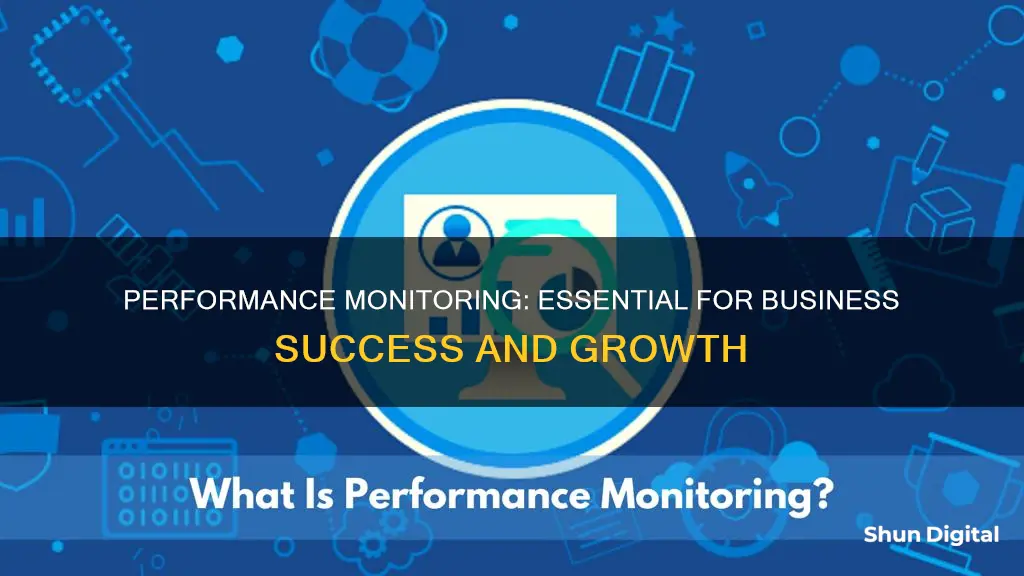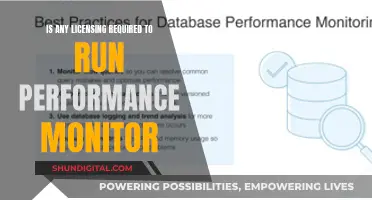
Performance monitoring is an essential component of how a company can perform its daily activities effectively. It involves tracking and analyzing a business's performance over a certain period to oversee and track its progress effectively. Performance monitoring is crucial for businesses to understand how they are running and to highlight areas that need improvement. It is also important for employee performance, as it helps HR make decisions regarding performance appraisals, coaching, and training requirements. Furthermore, it helps identify the right employees for promotions and improves employee retention. Performance monitoring is also key to understanding the basis, functionality, and optimization of digital platforms and channels, ensuring a flawless digital experience for users.
What You'll Learn

Tracking employee efficiency
There are several benefits to tracking employee efficiency:
Setting Clear Objectives:
Performance tracking helps set clear goals and expectations for employees. By defining specific objectives and tracking them, managers can ensure that employees understand their responsibilities and how their work aligns with the organisation's goals.
Transparency and Trust:
Tracking tools provide visibility into work processes and employee activities. This transparency reduces misunderstandings, builds trust, and fosters a collaborative environment where contributions are recognised.
Improved Productivity:
By identifying inefficiencies and areas for improvement, tracking tools help optimise workflows and enhance overall productivity. Managers can provide feedback to employees, encouraging them to adopt more efficient work habits.
Enhanced Task Prioritisation:
Tracking software enables the prioritisation of tasks based on urgency, importance, and deadlines. Features like to-do lists, project timelines, and priority markers help employees focus on critical tasks, reducing the risk of missed deadlines and improving efficiency.
Real-time Job Status Updates:
Managers and team members can instantly see the progress of tasks and projects, allowing them to make adjustments and address bottlenecks promptly. This ensures that projects stay on track and goals are met consistently.
Employee Recognition and Motivation:
Performance tracking helps identify top-performing employees who consistently deliver high-quality work. This information can be used for employee recognition, rewards, or public acknowledgement, boosting morale and motivating others.
- Performance Appraisal and Pay Structure:
- Career Path Decisions:
Continuous monitoring of employee performance assists HR in deciding suitable career paths for employees and planning human resource requirements. It ensures that promotions and career advancements are based on merit and evaluated scores.
Recruitment, Retention, and Termination:
Performance tracking plays a significant role in recruitment, retention, and termination decisions. Organisations value efficient employees and are willing to offer higher pay to retain them. Conversely, if performance is not up to the required standard, they may consider termination.
Training and Development:
By identifying skill gaps through performance tracking, organisations can design targeted training and development programs. This ensures that employees receive the necessary support to improve their skills and enhance their performance.
Overall, tracking employee efficiency is a critical aspect of performance monitoring, providing organisations with data-driven insights to make informed decisions, improve productivity, and achieve their goals.
Uncover Parental iPhone Monitoring: Privacy Protection Tips
You may want to see also

Identifying training needs
Performance monitoring is crucial for businesses to understand their employees' performance and identify areas for improvement. This process helps in establishing training and development needs by identifying skill gaps and selecting appropriate programs to bridge them. Here are some ways performance monitoring helps in identifying training needs:
- Tracking Employee Efficiency: Performance monitoring allows HR to evaluate and measure employee efficiency in meeting their Key Responsibility Areas (KRAs). By consistently measuring performance, companies can identify if goals are being consistently achieved and if there are any areas where employees are falling short. This information is crucial for designing effective training programs.
- Identifying Skill Gaps: Performance monitoring helps to identify skill gaps in both technical and soft skills. For example, an employee may be efficient in their technical skills but lack leadership or teamwork abilities. By identifying these gaps, HR can design targeted training programs to address these specific needs.
- Selecting Appropriate Training Programs: Performance monitoring is not just about identifying problems but also about finding solutions. Once the skill gaps are identified, HR can select the right training and development programs or coaching sessions to bridge those gaps.
- Measuring Effectiveness of Training Programs: Deploying training programs is just the first step. Performance monitoring helps to evaluate the success of these programs by tracking improvements in employee performance. This continuous assessment allows HR to identify if further improvements are needed and make necessary adjustments to the training modules or coaching sessions.
- Providing Constructive Feedback: Performance monitoring enables HR to provide constructive feedback to employees. Regular feedback helps build healthy relationships between employees and management and opens up a channel for two-way communication. This feedback loop is essential for employees to understand their strengths and weaknesses and for HR to identify further training needs.
Performance monitoring is a critical tool for businesses to identify training needs, improve employee performance, and enhance overall organisational productivity. By tracking employee efficiency, identifying skill gaps, selecting appropriate training programs, and measuring their effectiveness, companies can ensure that their employees have the necessary skills and abilities to drive the organisation's success.
Rick Ross' Ankle Monitor: A Legal Conundrum
You may want to see also

Measuring the effectiveness of training programs
Performance monitoring is important for businesses to keep track of how well their systems, applications, and employees are performing. It helps identify areas for improvement and ensures that operations run smoothly.
Training programs aim to improve employee performance, satisfaction, and overall morale while increasing the organization's return on investment (ROI). Measuring the effectiveness of these programs is essential to determine if they are achieving these desired outcomes. By evaluating the impact of training, organizations can identify if the training benefits employees and improves their skills and performance. Additionally, it provides employees with a clear understanding of their achievements and the path forward. Feedback and encouragement are crucial aspects of the learning process, and measurement allows for this to occur.
Furthermore, measuring the effectiveness of training programs helps uncover issues in the training process and facilitates continuous improvement. By collecting feedback and analyzing performance data, organizations can identify areas where the training content or delivery methods can be adjusted to better meet the needs of the employees and the organization as a whole. Regular evaluation enables businesses to refine their training programs, ensuring that they remain effective and relevant.
Learning and Development (L&D) programs, in particular, benefit from effectiveness measurements. These programs aim to create an atmosphere conducive to employee growth and improve productivity, efficiency, and profits for the organization. By assessing the input-to-output ratio and gathering feedback, organizations can tailor their L&D initiatives to align with their specific needs and objectives. This ensures that the allocated resources are utilized effectively, and the desired outcomes are achieved.
Finally, measuring the effectiveness of training programs contributes to the development of a learning culture within the organization. By providing regular feedback and opportunities for improvement, organizations foster an environment that values continuous learning and skill enhancement. This not only benefits individual employees but also strengthens the organization's overall capabilities and competitiveness in the market. It ensures that employees have the necessary knowledge and skills to excel in their roles, ultimately driving improved performance and productivity across the board.
HDR Monitor Buying Guide: Is It Worth the Money?
You may want to see also

Providing constructive feedback
Performance monitoring is important because employees are the driving force behind a company's success. Measuring how well your team is doing their job is vital to a business's success. Performance monitoring has positive effects on morale and the quality of work produced. It also helps businesses and employees unleash their full potential.
Constructive feedback is an essential part of performance monitoring. Here are some tips for providing constructive feedback:
Be Educational
Convey your feedback in an educational way. Call out unacceptable practices in a way that's neither rude nor arrogant, and present your feedback so your employee doesn't feel belittled or abused.
Balance Positive and Negative Feedback
Even the most challenging employee will have strengths. When addressing areas for improvement, also praise them for the things they do well. This helps to encourage a growth mindset, which is valuable for any employee.
Be Objective
Take people at face value and learn to listen to what they're saying instead of what they may be thinking. Keep their remarks in context and present your observations as objective observations.
Be Clear
Clear direction is vital as unclear or confusing direction is a significant source of workplace conflict. Make sure your team member knows exactly what you expect in terms of improvement.
Be Timely
Deliver feedback when it's still relevant. The fresher, the better. This helps the person make changes while they still have time to make an impact.
Be Specific
Focus on one target area for constructive feedback at a time. Receiving too much constructive feedback at once can be overwhelming.
Be Constructive, Not Critical
Give constructive feedback for the behaviour, not the person. For example, say "When you talk over Pam in meetings, you're making all the women on our team feel less comfortable speaking up", instead of "You're really rude to people, and it's dragging down the team".
Explain the Impact
Help the employee understand the full impact of their actions on you, the team, the company, and their career. This helps them see the issue clearly and creates a learning opportunity.
Offer Actionable Advice and Follow Up
Help the person figure out their next steps and set a time to meet and see their progress.
Eliminating QuickFit: A Guide to Monitor QuickFit Removal
You may want to see also

Recognising and rewarding employees
Motivating Employees:
Performance monitoring allows organisations to identify employees who consistently meet or exceed expectations. By recognising and rewarding these individuals, companies can motivate them to maintain or improve their performance. This recognition can take various forms, such as awards, certificates, monetary compensation, or other forms of appreciation. This not only boosts the morale of the recognised employees but also sets a positive example for their peers, fostering a culture of healthy competition.
Building a Supportive Work Environment:
Regular recognition and rewards contribute to creating a supportive and engaging work environment. When employees feel valued and appreciated, they are more likely to be satisfied with their jobs and the company. This, in turn, can lead to improved employee retention and a reduction in staff turnover. A supportive work environment also encourages employees to take ownership of their tasks and feel a sense of pride in their contributions, further enhancing their commitment to the organisation's goals.
- Enhancing Employee Productivity:
- Developing Emotional Connections:
Employee recognition goes beyond performance metrics. By celebrating strong efforts, going above and beyond, or adopting behaviours that align with the company's values, organisations can foster emotional connections between employees and the workplace. This, in turn, can fuel future performance and create a sense of loyalty and commitment to the company. Recognising employees for their contributions to team success and organisational culture is just as important as acknowledging individual achievements.
Providing Feedback and Guidance:
Performance monitoring allows managers to provide constructive feedback to employees through regular evaluations. This feedback helps employees understand their strengths and areas for improvement, guiding them in their professional development. By recognising employees' achievements and providing feedback, managers can create a two-way dialogue that empowers employees to take ownership of their growth and actively contribute to the company's success.
Fair Performance Appraisals:
Performance monitoring enables fair and transparent performance appraisals, which are essential for employee satisfaction and retention. By regularly monitoring and evaluating employee performance, organisations can make informed decisions regarding promotions, salary increments, or other career advancement opportunities. This fairness in performance evaluation and recognition helps foster a culture of trust and transparency between employees and management.
Connecting Cable to Monitor: A Step-by-Step Guide
You may want to see also
Frequently asked questions
Performance monitoring is important because it helps businesses understand how they are performing and what they can improve. This is especially important for digital businesses, where a slow website or app could result in losing customers.
Performance monitoring helps employees by giving them attention and guidance. It also helps to build strong relationships between management and employees, and facilitates career development.
Performance monitoring helps businesses to improve efficiency, save costs, and increase visibility over their operations. It also helps businesses identify issues and solutions, and ensures transparency.
Performance monitoring helps businesses to set, track, and meet their goals. It also helps to identify areas where employees may need additional support or training to achieve goals.
Performance monitoring provides businesses with data and insights to make informed decisions about strategy, procedures, and resource allocation. It also helps HR make decisions about performance appraisals, coaching, hiring, and firing.







